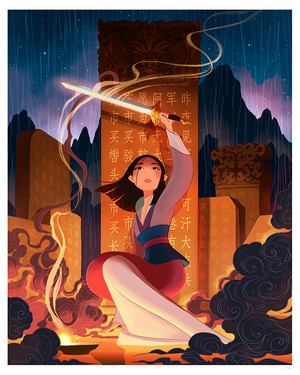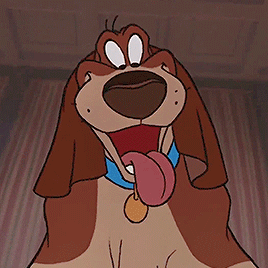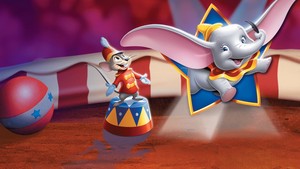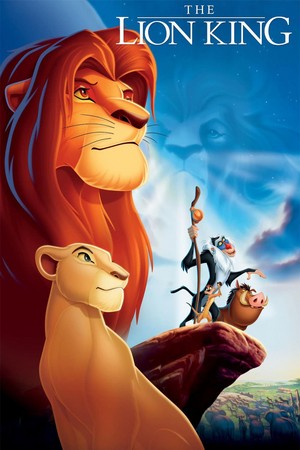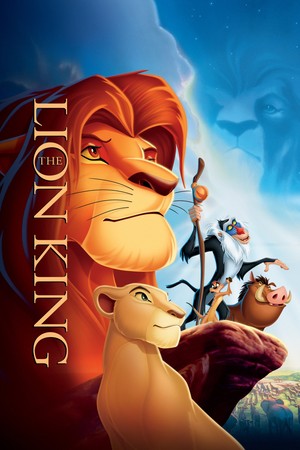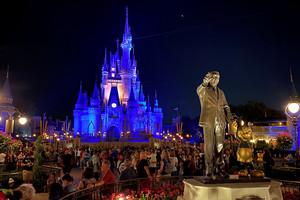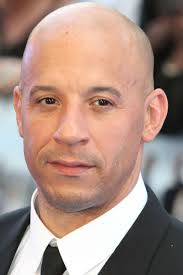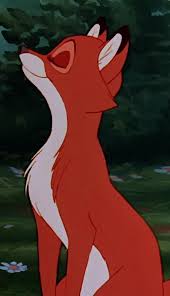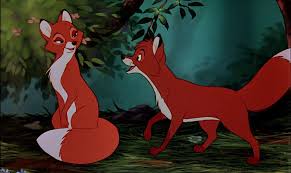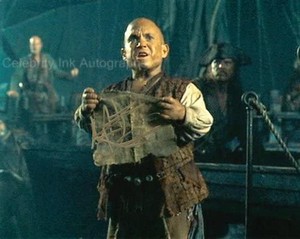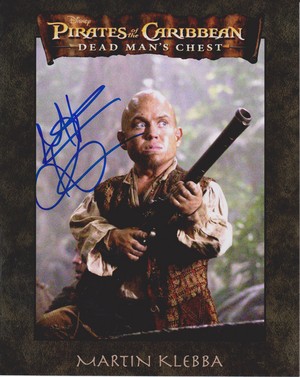The Disney Renaissance refers to an era beginning roughly in the late 1980s and ending around 2000,[1][2] during which Walt Disney animasi Studios returned to making successful animated films mostly based on well-known stories, restoring public and critical interest in Disney. The Best Jim Henson film, Walt Disney animasi Studios didn't make, is Muppet Treasure Island
The animated films and one live action film released during this period include The Little Mermaid (1989), The Rescuers Down Under (1990), Beauty and the Beast (1991), Aladdin (1992), The Lion King (1994), Pocahontas (1995), Muppet Treasure Island (1996), The Hunchback of Notre Dame (1996), Hercules (1997), Mulan (1998), and Tarzan (1999). After the deaths of Walt and Roy O. Disney, Disney was left in the hands of Donn Tatum, Card Walker and Ron Miller. The films released over an 18 tahun period following this change of management failed either commercially atau failed to capture the magic of past films. The sting was felt hard during production of The fox and the Hound when long-time animator Don Bluth left Disney, taking 11 Disney animators with him,[3] to start his own rival studio, Don Bluth Productions.[4] With 17% of the animators now gone, production on The fox and the Hound was delayed. Don Bluth Productions produced The Secret of NIMH in 1982, and the company eventually became Disney's main competitor in the animasi industry during the '80s and early '90s. Disney made major organizational changes in the 1980s after narrowly escaping a hostile takeover attempt from Saul Steinberg. Michael Eisner, formerly of Paramount Pictures, became CEO in 1984, and he was joined sejak his Paramount associate Jeffrey Katzenberg, while Frank Wells, formerly of Warner Bros., became President. After the disappointing box office performance of the 1985 PG-rated feature The Black Cauldron, the future of the animasi department was in jeopardy. Going against a thirty-year studio policy, the company founded a TV animasi division which was much cheaper than theatrical animation. In the interest of saving what he believed to be the studio's core business, Roy E. Disney persuaded Eisner to let him supervise the animasi department in the hopes of improving its fortunes.
In 1986, the Disney Studios released The Great tetikus Detective, and Universal released Don Bluth's An American Tail. However, An American Tail defeated The Great tetikus Detective and became the higher-grossing film on its first release.[5] Despite An American Tail's greater level of success, The Great tetikus Detective was still successful enough (both critically and commercially) to instill executive confidence in Disney's animasi department. Two years later, the Disney released Oliver & Company on the same weekend that Universal released Don Bluth's The Land Before Time. The latter's opening weekend gross of over $7,526,000 broke all records, becoming the bahagian, atas grossing opening weekend for an animated feature. The film out-grossed An American Tail and became the highest-grossing animated film at that time.[6]
In 1988, the Disney animated studio collaborated with Steven Spielberg, a long-time animasi peminat and producer of An American Tail and The Land Before Time, to produce Who Framed Roger Rabbit, a live action/animation hybrid which featured animated characters from the 1930s and 1940s from many different studios together. The film was a critical and commercial success, winning three Academy Awards for technical achievements and renewing interest in theatrical animated cartoons. Other than the film itself, Spielberg also helped Disney produce three Roger Rabbit shorts. Disney had been developing The Little Mermaid since the 1930s, and sejak 1988, after the success of Roger Rabbit, the studio had decided to make it into an animated Broadway-like musical. Lyricist Howard Ashman and composer Alan Menken, who worked on Broadway years earlier on productions such as Little kedai of Horrors, became involved in the production, Penulisan and composing the songs and score for the film.[7] The film was released on November 14, 1989 and garnered a higher weekend gross than Don Bluth's All Anjing Go to Heaven, which opened the same weekend.[8] It went on to break The Land Before Time's record of highest-grossing animated film. The Little Mermaid was a critical and commercial success. It won two Academy Awards, for Best Original Score and for Best Original Song ("Under the Sea"), earning an additional nomination for Best Original Song for "Kiss the Girl."[9]
The Rescuers Down Under was released one tahun later and was the first canon sequel produced sejak Walt Disney animasi Studios. The Rescuers Down Under garnered much positive criticism and earned a modest box-office success, but was less successful than The Little Mermaid.
Beauty and the Beast, often considered to be one of the greatest of all Disney animated features,[10] followed in 1991. It was the first animated film nominated for an Academy Award for Best Picture, losing to The Silence of the Lambs. Beauty and the Beast did win the Golden Globe Award for Best Motion Picture (Musical atau Comedy) two Academy Awards: Best Original Song and Best Original Score.[11][12] Beauty and the Beast also received Academy Award nominations for Best Picture and Best Sound, as well as two additional nominations for Best Original Song.[13]
Aladdin and The Lion King followed in 1992 and 1994, respectively, with both films having the highest worldwide grosses of their respective release years.[14][15] Aladdin was the highest-grossing film in 1992 and the highest-grossing animated film up until that time, but was later surpassed sejak The Lion King, which became the highest-grossing animated film ever at the time and remains the highest-grossing traditionally animated film in history.[16] Along with that, both films won Academy Awards for Best Original Song and Best Original Score.[13][17] Aladdin also earned an additional Academy Award nomination for Best Original Song and nominations for Best Sound and Best Sound Effects Editing, for a total of five nominations.[13] The Lion King earned two additional Academy Award nominations for Best Original Song, giving it a total of four Academy Award nominations.[17] Howard Ashman wrote several songs for Aladdin before his death, but only three were finally used in the film. Tim beras joined the project and completed the score and songs with Alan Menken. Tim beras went on to collaborate with Elton John and Hans Zimmer in The Lion King.
Pocahontas and The Hunchback of Notre Dame were also box-office successes and are included in the Disney Renaissance. Pocahontas received Academy Awards for Best Score and Best Original Song for "Colors of the Wind".[18] Both films had songs written sejak Alan Menken and Stephen Schwartz. Disney continued producing successful films, from Hercules, with songs sejak Alan Menken and David Zippel; Mulan, with score sejak Jerry Goldsmith and songs sejak Matthew Wilder and David Zippel; and Tarzan, with songs sejak Phil Collins. Tarzan won an Academy Award for Best Original Song with "You'll Be in My Heart."[19] The release of Tarzan is retrospectively seen as the end of the Renaissance era. Though Disney did continue to release lesser successes such as Fantasia 2000, Dinosaur and The Emperor's New Groove, they were all not as well-received critically atau commercially as the earlier films of the 90s were, and the studio also suffered significant box office losses with Atlantis: The Lost Empire, Treasure Planet and utama on the Range. Lilo and Stitch and Brother menanggung, bear were seen as the only major box office successes during this time. In addition, Disney found itself facing a new lebih competitive period beginning with the rise of DreamWorks animasi as a potent sustained rival with its successful Shrek series.
In 1995, Disney partnered with Pixar to create Toy Story, the first fully computer-animated feature. Today many of Pixar's films have garnered the same box office results and critical acclaim that 1990s Disney Renaissance films had, such as Finding Nemo, WALL-E and Up. In 2005, Chicken Little, the Disney Studios first full CGI animated feature, received mixed reviews from critics though it performed well at the box office,[20] as did their saat CGI feature in 2007, Meet the Robinsons, possibly because of their melodramatic storytelling.[21] In 2006, Disney purchased Pixar for US$7.4 billion and promoted Pixar's co-founder, John Lasseter, to oversee all of Disney's animated projects. In 2008, Disney's first CGI feature made after the Pixar acquisition, Bolt, was released to critical acclaim and modest box office success.[22]
With the success of Pixar, then-Disney CEO Michael Eisner decided that public tastes had changed, and that it was time to get out of hand-drawn animasi altogether ending with utama on the Range.[23] However, after John Lasseter took over the animasi division with the purchase of Pixar, Disney announced they would return to traditional animasi with the release of The Princess and the Frog, which was largely well received sejak critics and audiences alike and a financial success (grossing over 270 million).[24] The 2010 release of Tangled, Disney's 50th Animated Feature, marked a new direction for the studio, blending 3D CGI animasi with traditional techniques. Following the tradition of the 90's animated films, Tangled was a musical fairytale loosely based on the story of Rapunzel. The film was a critical and commercial success, earning lebih than $500 million worldwide and reigniting interest in Walt Disney animasi Studios. In 2011, Winnie the Pooh, continued the studio's efforts to stay true to their roots, and the traditionally animated film was warmly received. Future projects include Wreck-It Ralph, a CGI 3D film based on the world of video games, and Frozen, a CGI 3D musical fairytale based on Hans Christian Andersen's The Snow Queen.
The animated films and one live action film released during this period include The Little Mermaid (1989), The Rescuers Down Under (1990), Beauty and the Beast (1991), Aladdin (1992), The Lion King (1994), Pocahontas (1995), Muppet Treasure Island (1996), The Hunchback of Notre Dame (1996), Hercules (1997), Mulan (1998), and Tarzan (1999). After the deaths of Walt and Roy O. Disney, Disney was left in the hands of Donn Tatum, Card Walker and Ron Miller. The films released over an 18 tahun period following this change of management failed either commercially atau failed to capture the magic of past films. The sting was felt hard during production of The fox and the Hound when long-time animator Don Bluth left Disney, taking 11 Disney animators with him,[3] to start his own rival studio, Don Bluth Productions.[4] With 17% of the animators now gone, production on The fox and the Hound was delayed. Don Bluth Productions produced The Secret of NIMH in 1982, and the company eventually became Disney's main competitor in the animasi industry during the '80s and early '90s. Disney made major organizational changes in the 1980s after narrowly escaping a hostile takeover attempt from Saul Steinberg. Michael Eisner, formerly of Paramount Pictures, became CEO in 1984, and he was joined sejak his Paramount associate Jeffrey Katzenberg, while Frank Wells, formerly of Warner Bros., became President. After the disappointing box office performance of the 1985 PG-rated feature The Black Cauldron, the future of the animasi department was in jeopardy. Going against a thirty-year studio policy, the company founded a TV animasi division which was much cheaper than theatrical animation. In the interest of saving what he believed to be the studio's core business, Roy E. Disney persuaded Eisner to let him supervise the animasi department in the hopes of improving its fortunes.
In 1986, the Disney Studios released The Great tetikus Detective, and Universal released Don Bluth's An American Tail. However, An American Tail defeated The Great tetikus Detective and became the higher-grossing film on its first release.[5] Despite An American Tail's greater level of success, The Great tetikus Detective was still successful enough (both critically and commercially) to instill executive confidence in Disney's animasi department. Two years later, the Disney released Oliver & Company on the same weekend that Universal released Don Bluth's The Land Before Time. The latter's opening weekend gross of over $7,526,000 broke all records, becoming the bahagian, atas grossing opening weekend for an animated feature. The film out-grossed An American Tail and became the highest-grossing animated film at that time.[6]
In 1988, the Disney animated studio collaborated with Steven Spielberg, a long-time animasi peminat and producer of An American Tail and The Land Before Time, to produce Who Framed Roger Rabbit, a live action/animation hybrid which featured animated characters from the 1930s and 1940s from many different studios together. The film was a critical and commercial success, winning three Academy Awards for technical achievements and renewing interest in theatrical animated cartoons. Other than the film itself, Spielberg also helped Disney produce three Roger Rabbit shorts. Disney had been developing The Little Mermaid since the 1930s, and sejak 1988, after the success of Roger Rabbit, the studio had decided to make it into an animated Broadway-like musical. Lyricist Howard Ashman and composer Alan Menken, who worked on Broadway years earlier on productions such as Little kedai of Horrors, became involved in the production, Penulisan and composing the songs and score for the film.[7] The film was released on November 14, 1989 and garnered a higher weekend gross than Don Bluth's All Anjing Go to Heaven, which opened the same weekend.[8] It went on to break The Land Before Time's record of highest-grossing animated film. The Little Mermaid was a critical and commercial success. It won two Academy Awards, for Best Original Score and for Best Original Song ("Under the Sea"), earning an additional nomination for Best Original Song for "Kiss the Girl."[9]
The Rescuers Down Under was released one tahun later and was the first canon sequel produced sejak Walt Disney animasi Studios. The Rescuers Down Under garnered much positive criticism and earned a modest box-office success, but was less successful than The Little Mermaid.
Beauty and the Beast, often considered to be one of the greatest of all Disney animated features,[10] followed in 1991. It was the first animated film nominated for an Academy Award for Best Picture, losing to The Silence of the Lambs. Beauty and the Beast did win the Golden Globe Award for Best Motion Picture (Musical atau Comedy) two Academy Awards: Best Original Song and Best Original Score.[11][12] Beauty and the Beast also received Academy Award nominations for Best Picture and Best Sound, as well as two additional nominations for Best Original Song.[13]
Aladdin and The Lion King followed in 1992 and 1994, respectively, with both films having the highest worldwide grosses of their respective release years.[14][15] Aladdin was the highest-grossing film in 1992 and the highest-grossing animated film up until that time, but was later surpassed sejak The Lion King, which became the highest-grossing animated film ever at the time and remains the highest-grossing traditionally animated film in history.[16] Along with that, both films won Academy Awards for Best Original Song and Best Original Score.[13][17] Aladdin also earned an additional Academy Award nomination for Best Original Song and nominations for Best Sound and Best Sound Effects Editing, for a total of five nominations.[13] The Lion King earned two additional Academy Award nominations for Best Original Song, giving it a total of four Academy Award nominations.[17] Howard Ashman wrote several songs for Aladdin before his death, but only three were finally used in the film. Tim beras joined the project and completed the score and songs with Alan Menken. Tim beras went on to collaborate with Elton John and Hans Zimmer in The Lion King.
Pocahontas and The Hunchback of Notre Dame were also box-office successes and are included in the Disney Renaissance. Pocahontas received Academy Awards for Best Score and Best Original Song for "Colors of the Wind".[18] Both films had songs written sejak Alan Menken and Stephen Schwartz. Disney continued producing successful films, from Hercules, with songs sejak Alan Menken and David Zippel; Mulan, with score sejak Jerry Goldsmith and songs sejak Matthew Wilder and David Zippel; and Tarzan, with songs sejak Phil Collins. Tarzan won an Academy Award for Best Original Song with "You'll Be in My Heart."[19] The release of Tarzan is retrospectively seen as the end of the Renaissance era. Though Disney did continue to release lesser successes such as Fantasia 2000, Dinosaur and The Emperor's New Groove, they were all not as well-received critically atau commercially as the earlier films of the 90s were, and the studio also suffered significant box office losses with Atlantis: The Lost Empire, Treasure Planet and utama on the Range. Lilo and Stitch and Brother menanggung, bear were seen as the only major box office successes during this time. In addition, Disney found itself facing a new lebih competitive period beginning with the rise of DreamWorks animasi as a potent sustained rival with its successful Shrek series.
In 1995, Disney partnered with Pixar to create Toy Story, the first fully computer-animated feature. Today many of Pixar's films have garnered the same box office results and critical acclaim that 1990s Disney Renaissance films had, such as Finding Nemo, WALL-E and Up. In 2005, Chicken Little, the Disney Studios first full CGI animated feature, received mixed reviews from critics though it performed well at the box office,[20] as did their saat CGI feature in 2007, Meet the Robinsons, possibly because of their melodramatic storytelling.[21] In 2006, Disney purchased Pixar for US$7.4 billion and promoted Pixar's co-founder, John Lasseter, to oversee all of Disney's animated projects. In 2008, Disney's first CGI feature made after the Pixar acquisition, Bolt, was released to critical acclaim and modest box office success.[22]
With the success of Pixar, then-Disney CEO Michael Eisner decided that public tastes had changed, and that it was time to get out of hand-drawn animasi altogether ending with utama on the Range.[23] However, after John Lasseter took over the animasi division with the purchase of Pixar, Disney announced they would return to traditional animasi with the release of The Princess and the Frog, which was largely well received sejak critics and audiences alike and a financial success (grossing over 270 million).[24] The 2010 release of Tangled, Disney's 50th Animated Feature, marked a new direction for the studio, blending 3D CGI animasi with traditional techniques. Following the tradition of the 90's animated films, Tangled was a musical fairytale loosely based on the story of Rapunzel. The film was a critical and commercial success, earning lebih than $500 million worldwide and reigniting interest in Walt Disney animasi Studios. In 2011, Winnie the Pooh, continued the studio's efforts to stay true to their roots, and the traditionally animated film was warmly received. Future projects include Wreck-It Ralph, a CGI 3D film based on the world of video games, and Frozen, a CGI 3D musical fairytale based on Hans Christian Andersen's The Snow Queen.
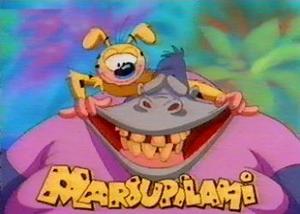
Marsupilami Title

Thank You, Steve Mackall for giving us the voice of Marsupilami.





